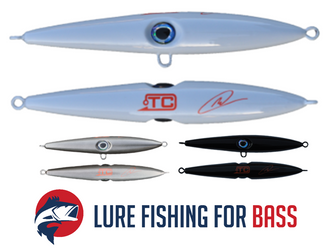Marc Cowling Signature Needlefish Lures
Posted by Marc Cowling (South Devon Bass Guide) on 3rd Mar 2020
Buy Marc's new lure HERE.
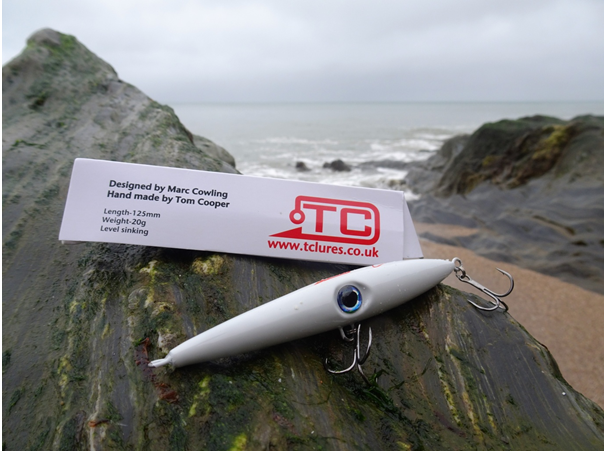
I was still shaken from what had occurred over the past three hours earlier that evening, as I lent against my car, sweating profusely whilst struggling to wipe the sweat from my brow and remove my wading boots from my aching feet. The one-and-half mile hike back to the car park, over fields and through various hedgerows had nothing to do with how I was now feeling either!
Nope, the reason I was a complete and utter wreck was because I had just received an epiphany (of sorts!)... I’d just experienced how devastatingly effective a 16cm ‘stick of rock’ weighing 20g, with treble hooks attached to it, retrieved in a straight line, in thigh-deep water covering the most snag-ridden terrain imaginable, in the pitch black, could be first-hand... From this seminal moment my fascination with Needlefish lures officially began!
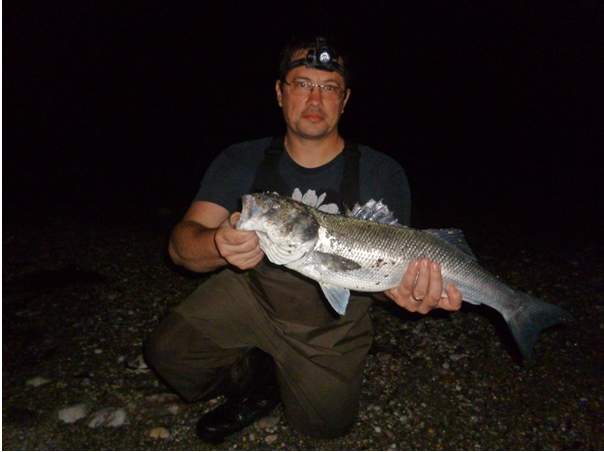
One of the 5lb bass landed and released on a Needlefish during that fateful sortie in the darkness – my client (George) was in shock than me I think (hence the miserable expression!).
It’s been almost 3 years now, since that humid, murky and magical session,one in which my client (above) had insisted on using his recent acquisition to subsequently land two 5lb bass and five in total. Achievements that my clients,during their guided sessions, and I (during my personal fishing sessions) have replicated time and again by landing dozens of bass over 5lb (including three over 8lb) on these innocuous, yet lethal lures,from a multitude of underwater environments.
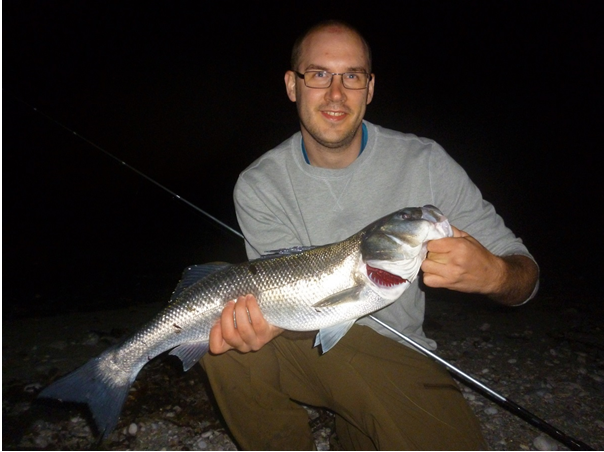
The first 8lb bass landed by a client (Lee) on a Needlefish, just as the Moon fleetingly appeared to completely illuminate the beach.
Contemplation
But catching lotsof bass, and happily, witnessing lots being caught as a professional guide, in addition to them generally being of a greater than average size in comparison to those caught and released on other lure types, wasn’t enough for me... The more I/we utilised, primarily, the wooden Jim’s Lures, and later, the plastic Super Strike Needlefish patterns, the more I came to wonder how a lure seemingly doing so little could be so effective. I wanted to, at least, attempt to figure out why this might be occurring, therefore, I commenced my investigations...
So initially then, I contemplated the way that these lures sank, and the way they transited through the water – on nothing more than a straight and steady retrieve, and without imparting any action through the rod incidentally. Following this, I scrutinised the following:Shape and Size.Colour.
- Shape
- Colour
- Types of venues (the ground/seabed) in which bass were regularly caught.
- The sea conditions most conducive to their use.
In conjunction with the catches courtesy of the longer-casting Needlefish, the elliptical/cylindrically-shaped and nodding/wobbling/zig-zagging (when retrieved) Albie Snax and the exceedingly subtle Wave Worm Bamboo Stick (that essentially travels in a straight and level trajectory when retrieved)has, thus far, accounted for well over 90% of the bass we have landed in darkness. I wondered therefore, whether a Needlefish incorporating all of these seemingly bass attracting qualities was something I could replicate, alongside getting someone highly skilled to actually build it for me!

One for me from a shingle beach leading onto reef,weed and rocks – the type of venue that I actively sought out once I had an inkling what the bass were looking for...
Confirmation
Digging deeper, and confirming some of the theories that I had, following some very interesting conversations with an extremely accomplished diver friend of mine (who, alongside being a Biologist, happens to dive mostly at night) a couple of ‘golden nuggets’ of information began to shed light on the nocturnal and predatory activities of our spikey friend the bass.
Typically, bass tended to be present where they could either expect to find food, or to be a position whereby they could corral or intercept it - no surprises there of course. But bearing in mind that I was still, at this stage, still relatively new to bass lure fishing in darkness, and had barely scratched the surface (in regards to the potential of my targeted ‘night-time’ marks) my diver friend went on to tell me four snippets that resonated with me – passionately so:
- During the spring, vast numbers of cuttlefish are prevalent and breeding in the shallows.
- During the autumn, large numbers of spawning squid are located very close inshore.
- ‘Silver’ fish species such as sprat, launce, herring, garfish and mackerel tend to almost ‘drift’ in the current as if they are in a comatose or torpid state during the hours of darkness.
- Bass will frequently ‘hit’ these food items, and more especially the smaller prey such as sprat head-first - seemingly using the eye as their ‘marker’ when hunting their quarry.
Going back to my deliberations then, I reasoned that alongside bass being far more confident (markedly so in fact) of venturing into the extreme shallows in the gloom. In addition to seeking out the usual prey items (crabs, prawns, sandeels, razorfish, worms and the like) it was highly probable that the cephalopods (squid and cuttlefish) and those silver fish species almost ‘levitating and lingering’ in the current were high up on the menu too. Moreover, when I later watched videos of these predators in their own right hovering, tilting and, more importantly, swimming in more or less a straight line, I was convinced that a Needlefish, with their very understated and almost ‘ghostly’ movement through the water was,more than likely imitating, or at the very least, representing, these very creatures...
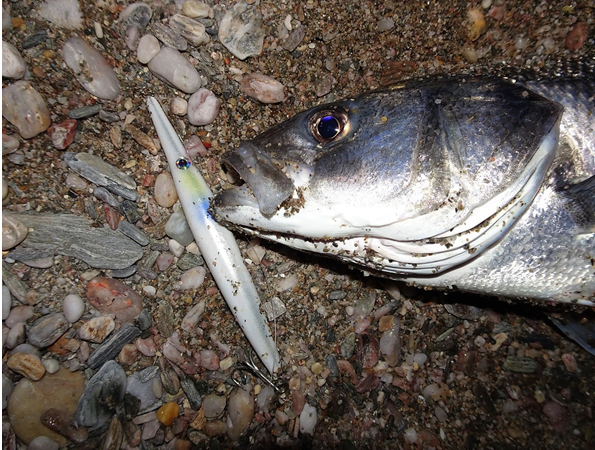
Another beauty! This one nailed a Jim’s Lures (James Lanfear) Needlefish in 40cm of water and only metres from dry land!
Of significance, is that I was astonished (and still am to this day) in regards to the number of times a bass would ‘smash into’ a Needlefish (or Albie Snax, and most definitely a Wave Worm) within seconds of it gently splashing on the surface, before elegantly descending through the water column. Another one of the wonderful facets to these brilliant lures is that the sink rate is extremely reliable, by virtue of how they are weighted. Providing you know the ground/seabed you are fishing over intimately, and the depth of water covering it in conjunction with any obvious snags or protruding rocks, means that so long as you’ve tested and confirmed the lure’s sink rate (in feet or centimetres per second and whether the Needlefish is level-sinking, or sinks tail-first or head-first) you shouldn’t (in theory) lose many at all. And even if you do, I’d say that eight times out of ten I’ve been able to return at low tide and simply pick them up off of the reef.
With the size, shape and overall movement covered, I pondered whether the colour would make a difference? The most obvious colour to use at night of course is white as it is the most visual, however, no-one really knows what fish sees in daylight, let alone in darkness.Although most of the successful sessions (in the early days) were conducted when the water was clear (more on that later) I strongly suspected that the bass were ‘homing’ in on these lures by utilising their other senses (lateral line for example to pick up tiny vibrations or the trace being emitted)long before they actually saw them up close – but who really knows? Either way,although I am now aware of bass being caught on exactly the same lure, but in Pink or Green configurations, in that first full season of using the Jim’s Lures Needlefish white was only colour that was used extensively, and that bestowed the most confidence when using it. A number of ‘chance encounters’ changed some of these perceptions however – for the better...
Silver Bullet
It was a very calm and still night, therefore, I didn’t really want to attach a wriggling, knocking shallow diving minnow to the lure clip - as from my experience up until that point, there was a risk that such a lure type could repel any bass present, rather than attract them. The Needlefish option was there, but there was a slight problem - I only had one left! Further, the coating on this one had effectively peeled like a banana skin and all that was left was the under layer – a silver foil-like substance courtesy of the lure being lost (when my lure clip failed) and being effectively dumped on a remote reef for two weeks, then left to rot in the saltwater over high water and bake in the mid-summer heat over low water each day and night – until I stumbled across it whilst out with a client!
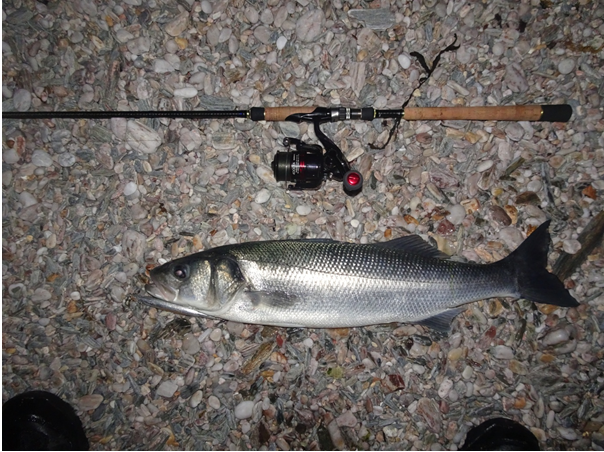
One of the first good-sized bass that seized the Silver Bullet!
This inadvertent ‘silver’ Jim’s Needlefish was in a terrible state externally, but had held up superbly internally. You know what happened next! I decided we should attach it and my client latched into an absolute beast that pulled him all over the place, before eventually evading capture when the hooks pulled out of its mouth after a screeching run... Dam!When I thought about it logically though, I/we had caught many bass on silver hard diving minnows, at night, previously, therefore there really was no reason why it wouldn’t be effective, just that all the confidence with the Needlefish so far had be achieved on a white pattern. To cut a long story short, said ‘battered lure’(that was subsequently nick-named the ‘Silver Bullet’) accounted for bass of 68cm and 70cm respectively among many others over the next fortnight– I was, yet again, convinced and remain so, that silver is a superb colour for night sorties!
Further occurrences,that encouraged me to amend my approach in order to enhance our catches in regards to colour, have been the realisation that sandeels are, on occasion, extremely active at night (something that I hadn’t personally experienced in the years prior to becoming a guide) particularly over sand/gravel/shingle (not surprisingly perhaps), but in very shallow water (knee-waist deep) and when there is a bright or high Moon present. What’s more, silver Needlefish and more so, those in black and that appear to be silhouetted against either the sky or the clean seabed (or both) went on to account for many bass – again, all in the dark.
Clean, open, exposed, sandy or shingle beaches with water so shallow it barely covers their backs, almost unbelievably, alongside my shallow reef marks became the types of venue where white, silver and black Needlefish have yielded bass over the past 3 years – especially throughout the 2019 season. And because I spend so much time guiding clients in darkness (in addition to when I get the opportunity during my solo endeavours), something that has become highly apparent is that the light levels (namely the amount of ambient light associated to the Moon, stars and twilight periods) and choosing the right lure and/or colour for these conditions can be the difference between a blank and a personal best whopper.

Utilising a black lure in darkness does work! The oversized eye on this wooden prototype helped to prove a theory too...
My preference has gradually evolved, to the extent that nowadays a tactic that serves me well is to (generally speaking) use a white lure on very dark nights, rough ground or in deeper water situations and a silver lure in intermittent light/some ambient light conditions (the Moon in/out/setting/rising or a half/crescent Moon, for instance) and mixed seabed conditions. A black lure has, predominantly, been reserved for those bright nights (full Moon), twilight or when fishing over pure sand and in very shallow water. That said, I don’t believe there any hard and fast rules here – as we are, after all, dealing with an unpredictable, wily and utterly wild creature swimming and feeding in the open ocean!
Finally the sea conditions... To date, I/we have caught bass on Needlefish of various shapes, sizes and colours in conditions ranging from as tranquil and as clear as they can get, to 6ft of swell causing lines of breaking waves (surf conditions essentially) and when a swell has been pushing up a shingle beach - highlighting the versatility of a Needlefish and the sea states in which they are effective. Something that I touched on earlier in this post though, and that is extremely pertinent, is that subtlety and stealth are the components that I cannot emphasise enough when lure fishing for bass in darkness – which is why I believe they are more effective when the sea is relatively calm, clear and without too much in the way of weed fragments floating about.
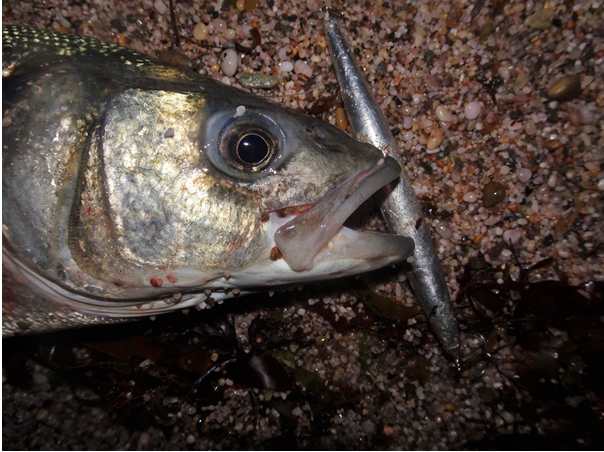
Too many bass of this size were evading capture for my liking, therefore a change to a smaller Needlefish was required in order to increase the ‘hook-up to being landed’ ratio!
Of course, bass can be caught on all lures in darkness I’m sure, but to really increase your chances of success you need to become the hunter-extraordinaire! The last thing you want to be doing is wading in, splashing about, talking, shouting and shining a light sporadically but directly on the water as the fish are sometimes literally centimetres away from you. Lure selection and way they are retrieved, I would suggest, plays more of a part in catching a bass in calm, clear, serene conditions (in the sort of environment they are desperate to invade, but won’t necessarily in daylight) than anything else.
Many Needlefish are, in essence, a hard stick bait/senko, and because they have virtually no intrinsic action and don’t make any noise (that we can hear) it does the same job underwater as the brilliantly subtle soft plastics I spoke about - with the added bonus of being incredibly stable in the waterand capable of being cast much further, if required. These are attributes that can and will enable you to catch more bass on occasion. As an example, an un-weighted soft plastic won’t penetrate into a cross or headwind as well as a Needlefish, nor will it remain under the water (on that deadly, level, trajectory) as the braid is swished about on the retrieve and the soft plastic pulled up onto the surface. Additionally, I can recall numerous occasions when, upon attaching a Needlefish in calm conditions in order to reach a specific submerged feature, has resulted in a powerful thud reverberating through the rod and line ‘first cast.’
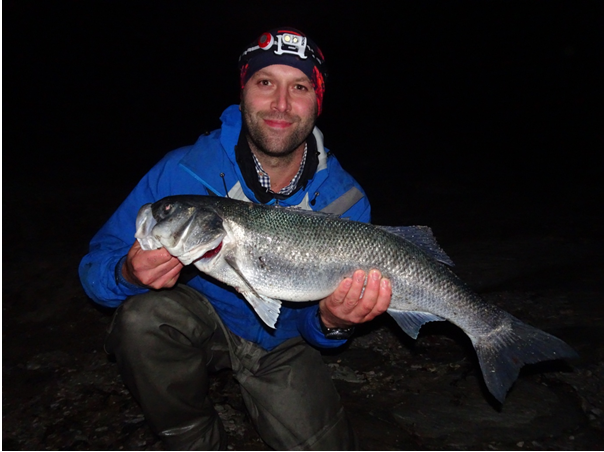
The man behind TC Lures (Tom Cooper) with a 70cm bass he landed during one of my 3 Day Guided Bass Fishing Packages in the summer of 2018.
Mitigation
Something bothered me though... The amount of good-sized bass (fish that were taking serious line) that appeared to ‘shake’ the hooks – around one in three fish (odds that I wasn’t happy with in all honesty). Again, I thought about this long and hard, and two things sprang to mind that could explain this: firstly, it is a known fact that bass will regularly attempt to ‘stun’ their prey with their armoured and razor-sharp gill plates by slashing at it, before then grabbing it. Secondly, the method in which bass of certain sizes seize their supper (your lure) alters with their age, size and apparent guile. Generally speaking, immature bass (up to 1lb say) will nip at the tail-end of a lure, whereas 2-6lb bass side-swipe their prey, and the big-ones – well, they just engulf or suck in their meal.
With the above in mind then, it was plausible that some of the hook-ups/lost fish my clients and I experienced were down to the bass effectively stunning the Needlefish and becoming foul hooked, before escaping. However, some of these wonderful moments occurred when a bass had utterly ‘nailed’ the lure good and proper and were dragging line off the spool at speed, whilst shaking their heads violently! My only explanation therefore,was that the substantial length (at 160mm) of the lures we were using alongside their rigidity, were allowing these older and wiser leviathans to ‘lever themselves’ off of the hooks... I needed to find a way to mitigate (as much as possible) the numbers of lost fish then.
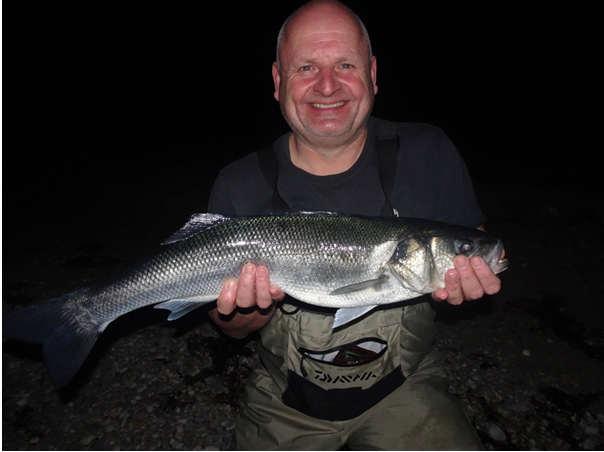
Yet another fantastic lure caught bass taken on a Needlefish. Are they suitable for use in daylight? I see absolutely no reason why not, although I have to admit to not giving it any time at all, even though I am thoroughly intrigued to find out!
Conception
So with all of the essential criteria firmly fixed in my mind, I drew up a list of constituents for my ‘quintessential Needlefish lure.’ Encompassed within any future design was as follows:
- Size - Particularly when the sea is warm and the bass are more active and athletic, I’d found that smaller lures (be it surface, sinking or diving) resulted in a better-than-average chance that the bass would just inhale it rather than attempting to stun it. Therefore, a Needlefish that was smaller in comparison to what I’d been using (of say 120-130mm) might increase the likelihood of an instant and firm hook-hold, in addition to decreasing the chance of a bass using the size and rigidity of the lure as leverage to escape.
- Weight – When I scrutinised the longest casting lures that I had in my collection, the ones that stood out all possessed what I would consider to be a superior size-to-weight ratio. For confirmation, I examined the many shorter yet slightly lighter versions of my commonly used hard diving minnows (the Tackle House Feed Shallow 105, Daiwa Shoreline Shiner 97F and Maria Squash F95 for instance) as I was often able to cast them further than their larger counterparts (the 128, 120F and 125 respectively) due to less wind resistance. Something that was therefore more compact in comparison to the Needlefish I’d been using previously but almost as heavy, and that could necessitate between 20-30% greater casting distance than an Albie Snax or Wave Worm (both of whose action I wanted to duplicate) was also required. Also, I wanted the way the lure splashed on the surface to be as deft and as subtle as possible, as I’d recognised that this was an attractant in itself... Of greater significance however, would be the way that that my Needlefish lure would be weighted so that it would not only sink horizontally, but would track under the water on a level trajectory, and not want to dip nose or tail first, or indeed rise to the surface on the retrieve.
- Shape – As the lure I had in my head would be shorter it would need to be on the ‘stubby’ side (wider) in order for it to maintain a controlled and easily distinguishable sink rate - the longer the lure, the more slender it can be essentially. A stroke of luck perhaps, but this actually married up with the almost oval, cylindrical, yet tapered and squid or small fish-like profile that I was after – a design that was not only unique, but also enabled the lure to behave differently depending on the speed at which it was retrieved (as covered under the ‘Movement’ heading below).
- Appearance – In conjunction with the overall shape and movement I just could not ignore what my diver friend had told me about bass attacking small fish head-first. Therefore an oversized 3D eye located in the centre of the lure and with a hook directly below it would (again, in theory) encourage bass to strike at this point on the lure, thus enhancing the ‘hook-up to actually landing’ ratio in tandem with its,overall, diminutive size. In field tests, even small ‘tail-nipping’ bass were regularly hooking themselves on the centrally positioned hook below the eye, rather than the rear hooks, even when I/we were using a black prototype – confirming the notion that bass are looking for that eye as their target.
- Sink rate and style–From a control perspective, being able to anticipate where a lure was located in the water column, whilst having the capability to utilise it in exceptionally shallow water over snag-ridden ground a sink rate of between 20-30cm per second was essential. Moreover, this would need to be perfected via vigorous testing and the positioning of any internal static weight and in synchrony with the material that the body would be built from. Every single lure built would need to perform in this manner - meaning uniformity would be paramount. Furthermore, when the lure descended in the water, I required it to remain horizontal as it did so – level sinking essentially, rather than nose or tail down, as I’d come to the conclusion that this behaviour mimics bait fish dying and sinking, or more especially, the hovering/levitating exploits typical of both cuttlefish and squid.
- Movement–‘Less is more’ as they say, and when it comes to lure fishing for bass at night, (particularly in those tranquil conditions I’ve mentioned) I couldn’t agree more. You don’t want to spook bass, but clearly you want to attract them! The scope then was for something that is tantalisingly elegant on the drop (control and what I like to call hit-ability) and stealth-like, highly responsive and manoeuvrable on the retrieve and that reacts instantly to flicks of the wrist, pauses or bursts of speed. The ‘flattened’ ovoid shape with pointed ends would also enable the lure to wobble slightly on a fast retrieve (like the Albie Snax) yet facilitate that all important straight, level and the real movement and trajectory on a slow to medium paced retrieve.
- Colour – Very simple - White, Silver and Black – all in line with my previous observations and catches, although I am intrigued about Green and Pink patterns for use in darkness...
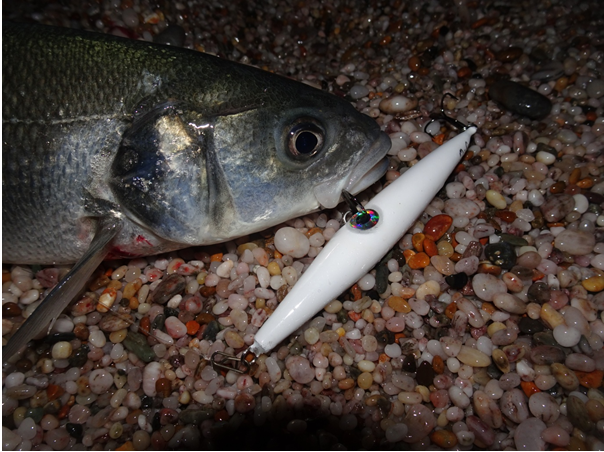
A good ‘client fish’ that snared one of the first wooden 17g prototypes built by Jim’s Lures.
Development
Early prototypes, a very small number of which are in circulation (around two dozen) were utilised extensively by my clients and I during the spring of 2019. These versions weighed 17g, were wooden and were in fact built by James Lanfear of Jim’s Lures. Pleasingly, those white, silver and black versions did catch a lot of bass from a multitude of marks and environments encompassing reefs, estuaries and sandy shorelines.
But it was the virtues of plastic (like the Super Strike Needlefish we’d caught bass on) or to be more precise, polyurethane, with its hardness, robustness and ability to be easily modified by altering its consistency so that the overall weight of the lure could be adjusted (serving to perfect and perform that essential consistent sink and swim rate) that I reasoned could be a more suitable option for my lure. It was at this stage that Tom Cooper, a Tree Surgeon, Sculptor and Lure Builder, showed me some his work whilst participating in his second 3 Day Guided Bass Fishing Package with me –they were fantastic, although at the time I assumed they were made of wood.
On a beautiful starlit night, whilst guiding him, Rob and Angus (the two others in the party) Tom landed a 66cm bass on one of his self-designed/self-built, hand-made Needlefish, followed an hour later by the largest bass a client has ever caught with me – a stunner of 73cm! What a night! But it was the next day, when I asked him if I could take a closer look at his creation that he informed me they were actually made out of plastic/polyurethane poured into a mould. I was gobsmacked!
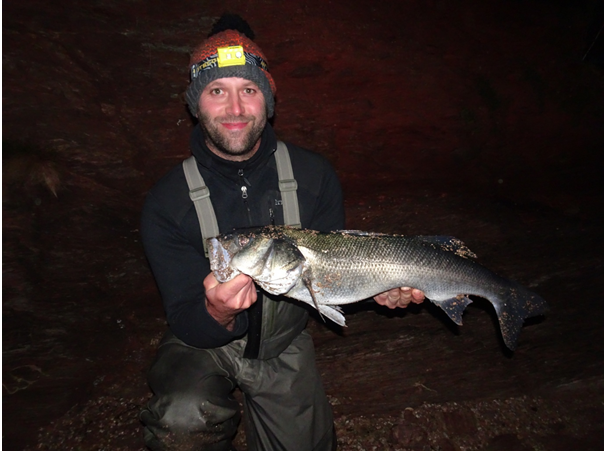
Tom Cooper with the 73cm bass (the largest a client has landed whilst being guided by me to date) landed within an hour of returning one of 66cm. Both fish took his self-designed, self-built plastic Needlefish.
A few months later, once my guiding season had quietened down that Tom and I began collaborating and I presented him with the blueprint.Since November 2019, Tom has been building and posting prototypes for me to test, so that every single component that I originally specified is incorporated. I therefore, I have great pleasure in presenting to you the ‘Marc Cowling Signature Needlefish 125 built by TC Lures.’
Marc Cowling Signature Needlefish 125
(Specification)
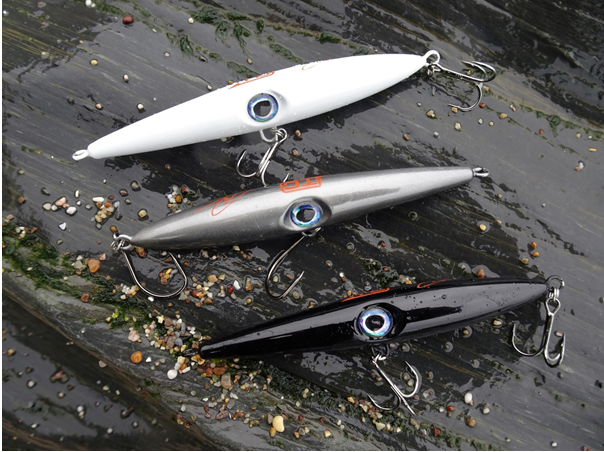
A full list of specifications for the Marc Cowling Signature Needlefish 125 can be found below:
- Length -125mm
- Weight - 20g.
- Level/Horizontal Sinking.
- Long casting (50m+).
- ‘Hand Cast’ polyurethane body (D72 on the shore hardness scale) for uniformity and durability.
- The density of the polyurethane has been adjusted to create the perfect ‘sink and swim’ rate.
- Marine Grade, 1mm 316 stainless through wire for robustness.
- Highly reflective 10mm 3D eyes.
- Four coats of ultra clear, hard and flexible top coat.
- From casting, the lure body, sanding, painting, logo and signature has been done ‘by hand’ to provide the best finish possible.
- Split Rings recommended – 7mm.
- Treble Hooks recommended – Size 2.
- Single Hooks recommended – Size 1/0.
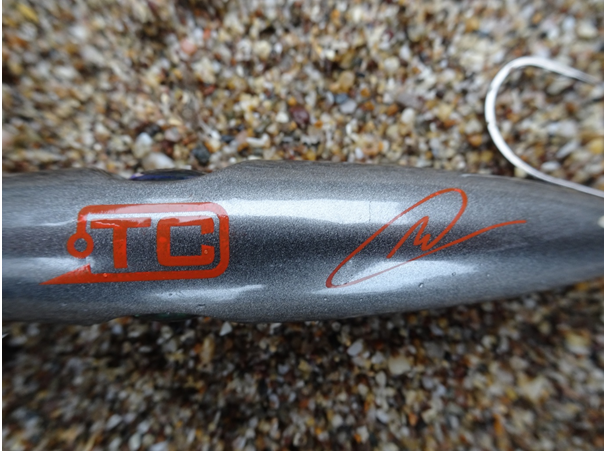
“Needlefish lures have become hugely popular for bass lure anglers in recent times, particularly in conjunction with the rise in popularity of lure fishing at night. Weighing 20g and measuring 125mm, these unique looking, long casting (50m+) hand-made (by Tom Cooper) level sinking needlefish have been formulated and developed by South Devon Bass Guide’s Marc Cowling.
Designed to mimic squid and cuttlefish (prevalent in the shallows during specific periods in the year around the UK coastline) they also represent prey fish that are known to essentially drift in a torpid/comatose state during the hours of darkness. These attributes are achieved by virtue of the lure’s elliptic shape, realistic and horizontal sink rate, high levels of responsiveness and manoeuvrability, in addition to the level and straight trajectory in which they travel underwater.
Incorporating a ‘hand cast’ polyurethane body for uniformity, finely-tuned density and durability, highly reflective and enlarged 10mm 3D eyes (that underwater predators target when hunting), 1mm marine grade stainless through wire and four layers of ultra clear and flexible top coat these lures have been hand- built (from the pouring process all the way through to paintwork and graphics) and rigorously tested for robustness, casting prowess and fish attracting capabilities.
The Marc Cowling Signature Needlefish is being introduced in three colours initially – a guide to their use can be found below:
- White - For use in very dark conditions, rocky and weedy ground and/or in deeper water.
- Silver - For use in intermittent or some ambient light conditions such as a half Moon, and/or over a mixed seabed in medium depths of water.
- Black - For use under a bright Moon, twilight conditions or when fishing over a clean seabed in exceptionally shallow water (when they are silhouetted).“

Furthermore, Marc has devised the following useful instructions and advice for their use:
*Please note that I have not used these lures in daylight. I see no reason why they wouldn’t be effective, just that I only have experience of using Needlefish lures in darkness*
- The ‘Signature Needlefish’ will generally cast further when a slower, smoother and higher trajectory is administered to the cast, over a snappier cast made at a lower trajectory.
- As soon as the Needlefish splashes on the surface, wind down as you normally would for a hard surface lure or diving minnow until you can ‘feel’ it’s weight through the rod/line.
- From the moment it enters the water, the lure will sink, horizontally (level) at a rate of approximately 20-30cm per second, enabling the angler to determine where in the water column the lure is in relation to the seabed.
- Once the desired depth has been achieved, commence with a steady and constant retrieve of approximately two full turns of the reel’s handle per second (if you want the lure to swim with a slight wobble to it) and between a half and one full turn per second if you want the lure to swim in a straight line. *when using a 3000 size reel with a retrieve ratio of 6.0:1*
- If your stance is above sea level, then holding the rod with the tip down will ensure the lure remains submerged when it is approaching you. If you are stood at sea level or actually in the water then holding the rod up at between 20-40o before gradually lowering it as the lure approaches you is recommended.
- Pauses, twitches and changes of speed to the retrieve (to mimic a vulnerable or fleeing prey item) can also be highly effective, and the responsiveness and manoeuvrability of this lure lends itself well to this approach. Enjoy practising with it in daylight!
- Due to the extremely subtle manner in which the lure travels through the water in line with what it is designed to represent, it is best suited to be utilised in very calm sea conditions over any type of seabed,or in up to 3ft of surf/breaking lines of waves turning over a clean seabed.
Buy Marc's new lure HERE

